NCERT Solutions for Class 12 Political Science Challenges of Nation Building
NCERT Solutions for Class 12 Political Science Chapter 1 Challenges of Nation Building
TEXTBOOK QUESTIONS SOLVED
1. Which among the following statements
about the partition is incorrect?
(a) Partition of India was the outcome of the “two-nation theory”.
(b) Punjab and Bengal were the two provinces divided on the basis of religion.
(c) East Pakistan and West Pakistan were not contiguous.
(d) The scheme of Partition included a plan for transfer of population across the border.
Answer: (d) The scheme of partition included a plan for transfer of population across the border.
2. Match the principles with instances: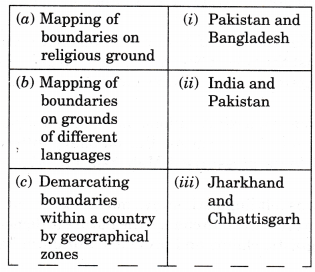
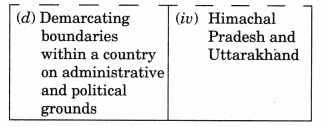
Answer: (a)-(ii), (b)-(iv), (c)-(i), (d)-(iii)
3. Take a current political map of India (showing outlines of states) and mark the location of the following Princely States,
(a) Junagadh (b) Manipur
(c) Mysore (d) Gwalior.
Answer: Please see the Map attached at the end of the chapter. The places are marked as 3(a), 3(b), 3(c) and 3(d).
4. Here are two opinions:
Bismay: “The merger with the Indian State was an extension of democracy to the people of the Princely States.” Inderpreet: “I am not so sure, there was force being used. Democracy comes by creating consensus. ”
What is your opinion in the light of accession of Princely States and the responses of the people in these parts?
Answer: Accession of Princely States and merger with Indian union was to expand democracy all over the country because princely states never enjoyed their political rights. Indian government central government used force to extend democracy to some extent as this was mandatory to have a uniform base in the country.
5. Read the following very different statements made in August 1947: “Today you have worn on your heads a crown of thorns. The seat of power is a nasty thing. You have to remain ever wakeful on that seat… you have to he more humble and forbearing… now there will be no end to your being tested. ”
-M.K, Gandhi “India will awake to a life of freedom…. we step out from, the old to the new…. we end, today a period of ill fortune and India discovers herself again. The achievement we celebrate today is but a step, an opening of opportunity …”,
-Jawaharlal Nehru Spell out the agenda of nation building that flows from these two statements. Which one appeals more to you and why?
Answer: These two statements focus on the agenda of secularism, democracy, sovereignty and freedom. It focuses on the path which will lead to the real development and prosperity of our country. The first statement appeals to me more than the second one because it invokes the countrymen to remain awake, alert and conscious as it is not the end of our struggle. The time to build the nation initiates now.
6. What are the reasons being used by Nehru for keeping India secular? Do you think these reasons were only ethical and sentimental? Or were there some prudential reasons as well?
Answer: Reasons for keeping India secular:
1. All the Muslims did not leave India during participation, some muslims stayed in India as a minority and Jawaharlal Nehru wanted to deal with them in a very civilised and dignified manner.
2. He advocated security and democratic rights of Muslims as a citizen of India.
No, these reasons were not only ethical and sentimental, but there were some prudential reasons also as:
1. India’s secular nature cherished its long term goals and principles
like socialism, equality, liberty and fraternity.
2. Secularism stops any single faith to become superior and inferior to those who practicised another religion. Hence it considers all citizens equal irrespective of religious affiliation.
7. Bring out two major differences between the challenge of nation building for eastern and western regions of the country at the time of Independence.
Answer: The two major differences between eastern (Bengal) and Western (Punjab) regions can be summed up as follows:
1. These regions were the muslim majority provinces to be joined. Hence, it was decided that new country Pakistan will comprise two territories i.e. West and East Pakistan.
2. Secondly, there was a problem of minorities on both sides of border (East and West). Lakhs of Hindus and Sikhs in areas of Pakistan and Muslims on the Indian side of Punjab and Bengal found themselves trapped with no option except to leave their homes.
8. What was the task of the States Reorganisation Commission? What was its most salient recommendation?
Answer: The State Reorganisation Commission was set up in 1953 by central government to look into the matter of redrawing of boundaries of state:
1. The commission evolved that states’ boundaries should reflect the boundaries of different languages to accommodate linguistic diversity.
2. The State Reorganisation Act was passed in 1956 which resulted the creation of 14 states and 6 union territories.
3. Its most salient recommendation was the formation of linguistic states i.e. to reorganise states on the basis of accommodation of their languages to prepare a uniform base for the nation.
9. It is said that the nation is to large extent an “imagined community” held together by common beliefs, history, political aspirations and imaginations. Identify the features that make India a nation.
Answer: India proved herself through all stages of three challenges at the time of nation building like:
1. India is a secular country where people speak different languages and follow different cultures and religions to be recognised as a nation of unity in diversity with common faith and beliefs.
2. Political aspiration ensures demo¬cratic setup based on parliamentary form of government creating political competition in a democratic framework.
3. India’s imaginations established a welfare state on the principle of equality and special protection to socially disadvantaged groups and religions as well as cultural communities.
10. Read the following passage and answer the questions below:
“In the history of nation-building only the Soviet experiment bears comparison with the Indian. There too, a sense of unity had to be forged between many diverse ethnic groups, religious, linguistic communities and social classes. The scale-geographic as well as demographic was comparably massive. The raw material the state had to work with was equally unpropitious: a people divided by faith and driven by debt and disease.”
—Ramachandra Guha
(a) List the commonalities that the author mentions between India and Soviet Union and give one example for each of these from India.
(b) The author does not talk about dissimilarities between the two experiments. Can you mention two dissimilarities?
(c) In retrospect which of these two experiments worked better and why?
Answer: (a) Commonalities between India and Soviet Union:
(i) Both the nations shaped the nation on linguistic basis.
(ii) To promote welfare motives, the economic and technological developments took place in India also.
(iii) States were divided on the grounds of geographical boundary and strength of populations also in both the nations.
(b) Dissimilarities:
(i) Soviet Union was divided into 15 independent republics/countries to be disintegrated.
(ii) India maintained its unity and integrity even among diversified nature of states and peoples without any more division.
(c) The Indian experiment worked better to promote linguistic and cultural plurality without affecting unity and integrity of the nation though India adopted some diplomatic measures to make country united.
MORE QUESTIONS SOLVED
Very Short Answer Type Questions [1 Mark]
1. Name the leader who played a historic role in negotiating with the rulers of princely states to join the Indian Union.
Answer: Sardar Vallabhbhai Patel
2. What is meant by Two Nation Theory?
Answer: Two Nation Theory was propounded by Muhammad Ali Jinnah to create separate state for Muslims.
3. Mention the main recommendation of the State Reorganisation Commission of 1953.
Answer: The main recommendation of the State Reorganisation Commission was to organise states on language basis and the boundaries of states could also reflect the linguistic aspects.
4. Which two languages were spoken in Bombay state before it was divided in 1960?
Answer: Gujarati and Marathi
5. Name any four princely states that resisted their merger with the Indian Union?
Answer: Junagadh, Hyderabad, Kashmir and Manipur.
6. How many princely states consisted at the time of independence of India?
Answer: 565 princely states.
7. What was meant by princely states?
Answer: Princely states were ruled by princes who employed some form of control over their internal affairs under the supremacy of the British.
8. What was the basis of the report of States Reorganisation Commission?
Answer: States Reorganisation Commission Report was based on the distribution of boundaries of states on language basis to reflect linguistic aspects.
9. Why were the states reorganised on linguistic basis in India in 1956?
Answer: States were reorganised on linguistic basis in India in 1956 to maintain unity and integrity of the nation to avoid violence and conflicts among the people.
10. Whose speech was known as ‘tryst with destiny’?
Answer. ‘Tryst with destiny’ speech was delivered by the first Prime Minister of independent India Pt. Jawahar Lai Nehru while addressing special session of constituent Assembly as the midnight of 14-15 August 1947.
11. Name the states which decided to remain independent in place of joining India.
Answer: Travancore, Junagadh, Hyderabad and Bhopal decided to remain independent.
12. In which Congress Session proposal for linguistic principles of reorganisation was accepted?
Answer: Nagpur Congress Session of 1920.
13. Name the movement which demanded the separate province for Andhra region.
Answer: The Vishalandhra movement demanded that Telugu speaking areas should be separated from Madras Province of which they were a part and be made into a separate Andhra Province.
14. Why did Amritsar and Kolkata become communal zones?
Answer: Amritsar and Kolkata became communal zones because Muslims did not wish to move into area of Hindus and Sikhs majority and on the other hand Hindus and Sikhs also wanted to stay away from the areas of Muslim predominance.
15. Define Globalisation.
Answer: Globalisation refers to integration of an economy with the other country based on interdependence.
16. What is WSF?
Answer: WSF is the World Social Forum, a global platform to bring together a wide coalition of human rights activists, environmentalists and women activists.
Very Short Answer Type Questions [2 Marks]
1. Identify any two consequences of the partition of India in 1947.
Answer: 1. Communal Riots took place as the people of one community were killed and maimed by the people of other community in the name of religion.
2. People went through immense sufferings as they were forced to abandon their homes and to secure temporary shelter in the refugee camps. Thousands of women were abducted on both sides of border.
2. Mention any two challenges that India faced just after independence.
Answer: (i) Challenge to shape a nation
(ii) Challenges to establish democracy.
Or
(iii) Challenge to ensure the development and well being of the entire society.
3. Name the original states from which the following states were carved out.
(a) Meghalaya (b) Gujarat
Answer: (a) Assam (1972) (b) Bombay (1960)
4. Explain the role played by Sardar Patel in the integration of princely states into the Indian Union.
Answer. Sardar Patel negotiated with the rulers of princely states and diplomatically merged most of them into the Indian Union i.e. there were 26 small states in today’s Orissa and 14 big states and 119 small states in today’s Gujarat.
5. Which state got divided on bilingual basis?
Answer: Bombay got divided on bilingual basis consisting of Gujarat and Marathi speaking people. After popular agitation, the states of Maharashtra and Gujarat were created in 1960.
6. Name the leader who advocated separate state of Andhra Pradesh by observing fast unto death and participation in Salt Satyagraha.
Answer: The leader Potti Sriramulu of Madras resigned from government job to participate in Salt Satyagraha and advocated equality in the society and demanded entry of dalits in temples of Madras as well as observed fast unto death since 19 October 1952 to create separate state of Andhra Pradesh
7. What was government’s approach towards the integration of princely states was based on three considerations?
Answer: 1. Most of the princely states willingly wanted to join Indian Union.
2. The government wanted to accommo¬date plurality by adopting flexible approach in dealing with the demand of the region.
3. The central government was so much concerned towards integration and consolidation of territorial boundaries of Indian nation.
8. Which interests were hidden behind the conflicts between Hindus and Muslims at the time of independence?
Answer: Hindu and Muslim communities bear some political interests at the time of independence:
1. Muslim League demanded a separate nation for Muslims to protect the interests of Muslims only.
2. There were some Hindu organisations also which made efforts to look after the interests of Hindus only to make India a ‘Hindu Nation’.
9. “India got independence under very difficult circumstances rather than any other country”. Justify the statement.
Answer: India got independence in 1947 under very difficult circumstances:
1. Freedom came with the partition of the country.
2. The year 1947 became the year of unprecedented violence and trauma.
3. Still our leader faced all these challenges in an appreciable manner by accommodating regional diversities also.
Short Answer Type Questions [4 Marks]
1. How has the princely state of Manipur acceded to India?
Answer: Due to integration of princely states, Maharaja of Manipur Bodhachandra Singh signed the Instrument of Accession with the India Government on the assurance to be maintained the internal autonomy of Manipur:
1. The state became a constitutional Monarchy after it conducted elections in 1948 to become first state to hold elections based on ‘Universal Adult Franchise’.
2. But sharp differences arose in Legislative Assembly over the question of merger of Manipur with India while the state congress wanted the merger other political parties were opposed to this.
2. Describe briefly any four problems faced in the process of partition of India.
Answer: The process of partition had been started in 1940 when Muslim League Propounded Two Nation Theory. This process involved various problems:
1. Areas were supposed to be distributed on the basis of religions majority i.e. Muslim majority areas built Pakistani territory and rest stayed with India. It created communal riots in country.
2. No single belt of muslim majority was the part of British India. They were concentrated in East and West. Hence, it was decided that Pakistan will comprise two territories namely East and West Pakistan separated by long expansion of India territory.
3. All muslim majority areas did not want to be merged with Pakistan
i. e. it was opposed in NWFP. But ultimately NW.FP was made to merge with Pakistan.
4. Another problem belonged to minorities on both sides of border
i. e. Lakhs of Hindus and Muslims and Sikhs from both the sides were left with no option except to leave their homes.
3. Name the states divided on the basis of sub-regional culture.
Answer: In the late 20th century, some states sub-regions raised the voice for separate states accommodating their regional culture on the ground of complaints of regional imbalances. Jharkhand, Chhattisgarh, and Uttaranchal were created in 2000 on the basis of separate regional culture only.
4. Explain three challenges which independent India faced during the process of Nation Building.
Answer: India had to face many challenges immediately after she got independence, which can be summed up as follows:
1. Challenge to Shape a Nation: India was divided among various states at the time of independence. Hence a great challenge arose to unity and integrate country into one bond Sardar Vallabhbhai Patel took upon himself to integrate these states either wilfully or diplomatically to be completed into different stages.
2. To Establish Democratic Setup: India constituted representative democracy based on parliamentary form of government and it was a great challenge to develop these democratic practices in the nation.
3. To Ensure Development and Well Being of the Society: Indian polity made herself to achieve welfare goods with the environment of effective economic policies and eradication of poverty and unemployment.
5. What problems were involved at the integration of princely states during nation building?
Answer: Integration of princely states possessed many difficulties in front of nation builders:
1. British announced to lapse of British
Paramountcy over princely states with the end of their rule over India.
2. British government took the view that all these states were free to join either India or Pakistan or remain independent wilfully. It became a hindrance for unity of nation.
3. Ruler of Travancore declared the states an independent one.
4. Nizam of Hyderabad and Bhopal also followed Travancore.
5. These responses created a possibility of division of country in place of unity and democracy.
6. Write a short note on the people’s movement of Hyderabad.
Answer: Hyderabad was the largest princely state of India under the rule of Nizam. One of the world’s richest person. Nizam wanted Hyderabad to be an independent state. But the people of Hyderabad were not happy with the rule of Nizam due to his non-democratic practices. Hence, various section of society agitated against him:
1. The peasants in Telangana region particularly rose voice against him.
2. Women also joined the movement in large number.
3. The communist and Hyderabad congress were in the forefront of movement.
4. Nizam responded by unbashing a Razakars paramilitary force on people.
5. Ultimately, the central government had to order the army to tackle and in 1948, Indian army moved in control the Nizam’s forces.
All the above mentioned situations led to an accession of Hyderabad.
7. What was the significance of linguistic reorganisation of Indian states to the nation building?
Answer: In the initial years it was felt that linguistic states may foster separatism and create pressures on newly founded nation. But India considered democracy and federalism by making a favour to linguistic states only:
1. Linguistic states enhanced democratic practices.
2. Linguistic states reduced separatist attitude by accepting the regional linguistic claims of all regions.
3. Linguistic reorganisation provided a uniform base to the nation and strengthened unity of nation.
4. Linguistic states promoted the principle of unity in diversity, a distinct feature of nation.
Passage Based Questions [5 Marks]
1. Read the passage given below carefully and answer the following questions:
The interim government took a firm stance against the possible division of India into smaller principalities of different sizes. The Muslim League opposed the Indian National Congress and took the view that the States should be free to adopt any course they liked. Sardar Patel, India’s Deputy Prime Minister and the Home Minister during the crucial period, immediately after Independence, played a historic role in negotiating with the rulers of Princely States in bringing most of them into the Indian Union.
Questions
1. Which government has been referred to as the interim government?
2. Why did the Muslim League oppose the Indian National Congress?
3. What makes the role of Sardar Patel a historic one? Explain.
Answer:
1. The Indian National Congress has been referred to as the interim government.
2. The Muslim League opposed the Indian National Congress because it was of the view that the states should be free to adopt any course they liked.
3. Sardar Patel was India’s Deputy Prime Minister and the Home Minister during the crucial period immediately following Independence. He negotiated with the rulers of princely states firmly but diplomatically and brought most of them into the Indian Union.
2. Read the passage given below carefully and answer the questions:
We should begin to work in that spirit and in course of time all these angularities of the majority and minority communities, the Hindu community and the Muslim community-because even as regards Muslims you have Pathans, Punjabis, Shias, Sunnis and so on and among the Hindus you have Brahmins, Vaishnavas, Khatris, also Bengalees, Madrasis, and so on-will vanish. … You are free; you are free to go to your temples, you are free to go to your mosques or to any other place of worship in this State of Pakistan. You may belong to any religion or caste or creed-that has nothing to do with the business of the State.
—Mohammad Ali Jinnah
Questions
1. Do you think that Jinnah’s statement contradicts the theory which was the basis of creation of Pakistan? Justify your answer.
2. What is the essence of Jinnah’s statement in this passage?
3. To what extent did Pakistan live up to Jinnah’s expectations in this passage?
Answer:
1. Jinnah’s statement does not con-tradict the ‘Two Nations’ Theory’ as he aimed at the creation of separate state for Muslims without any interference in other communities like Pathans, Punjabis, Shias and Sunnis.
2. The essence of Jinnah’s statement in this passage is his secular outlook regarding the protection and promotion of every community by giving freedom to practices one’s own beliefs (religiously).
3. Pakistan did not live up to Jinnah’s expectations because Pakistan became an orthodox Muslim country that did not respect interests of another communities after indepen-dence.
3. Read the passage given below carefully and answer the questions:
We have a Muslim minority who are so large in numbers that they cannot, even if they want, go anywhere else. That is a basic fact about which there can be no argument.. Whatever the provocation from Pakistan and whatever the indignities and horrors inflicted on non-Muslims there, we have got to deal with this minority in a civilised manner. We must give them security and the rights of citizens in a democratic state. If we fail to do so, we shall have a festering sore which will eventually poison the whole body politic and probably destroy it.
—Jawaharlal Nehru
Questions
1. Why did Jawaharlal Nehru want to deal with the muslim minority in a civilised way?
2. Why this minority should be given the security and rights-on the same footing as 20 all others in a democratic system?
3. If this minority was not provided security and rights w’hat kind of scenario is envisaged?
Answer:
1. Because India adopted democracy which commit equal rights and opportunities to each and every human being in place of dividing them.
2. It was argued by Jawaharlal Nehru not only for ethical and sentimental reasons but prudential reasons also to realise long cherished goals and principles as socialism, equality, and fraternity.
3. If this minority was not provided security and rights it may effect:
1. Basic nature of democratic system.
2. It is against secular nature of India.
3. It may effect India’s foreign policy also.
4. It may threat to other minorities also.
5. Most important it may lead to disintegration of the nation.
Long Answer Type Questions [6 Marks]
1. What forced the Union Government of India to appoint the State Reorganisation Commission in 1953? Mention its two main recommendations. Name any four new states formed after 1956.
Answer: 1. State Reorganisation Commission was appointed in 1953 by central Government to rearrange the boundaries of states.
2. Its main recommendations were to organise states on language basis as well as the boundaries of state could reflect the linguistic aspects also.
3. The Madras province under British India created following linguistic states:
(a) Andhra Pradesh (Telugu)
(b) Tamilnadu (Tamil)
(c) Kerala (Malayalam)
(cl) Karnataka (Kannad)
4. The state Reorganisation Act was passed in 1956 which created 14 states and 6 Union territories.
2. Explain any three challenges faced by India at the time of its independence.
Answer: India had to face many challenges immediately after she got independence, which can be summed up as follows:
1. Challenge to Shape a Nation: India was divided among various states at the time of independence. Hence a great challenge arose to unify and integrate country into one bond. Sardar Vallabhbhai Patel took upon himself to integrate these states either wishfully or diplomatically to be completed into different stages.
2. To Establish Democratic Set up: India constituted representative democracy based on parliamentary form of government and it was a great challenge to develop these democratic practices in the nation.
3. To Ensure Development and Well Being of the Society: Indian polity made herself to achieve welfare goals with the evolvement of effective economic policies and eradication of poverty and unemployment.
3. How did the reorganisation of states take place in India after its independence? Explain.
Answer: 1. In the initial years it was felt that linguistic states may foster seperatism and create pressures on newly founded nation, but India considered democracy and federalism by making a favour to linguistic states only.
2. State Reorganisation Commission was appointed in 1953 central Government to rearrange the boundaries of states.
3. Its main recommendations were to organise states on language basis as well as the boundaries of states could reflect the linguistic aspects also.
4. The State Reorganisation Act was passed in 1956 which created 14 states and 6 union territories.
5. Linguistic states enhanced demo¬cratic practices.
6. Linguistic states reduced separatist attitude by accepting the regional and linguistic claims of all regions.
4. Explain any three consequences of partition in India.
Answer: 1. In the name of religion, people of one community killed and mained people of the other community. Cities like Lahore, Kolkata and Amritsar were titled as communal zones.
2. People went through social sufferings also be forced to abandon their homes especially minorities, who took shelter in refugee camps.
3. To preserve the honour of family, many women were killed even many children were separated from their family and if crossed borders, they did not have any home.
4. The partition did not only divide property, assets or liabilities but also the government employees and the railways etc.
5. Assess the role played by Sardar Vallabhbhai Patel in nation building.
Answer: Sardar Vallabhbhai Patel is also known as ‘Iron man of India’, became India’s Deputy Prime minister and Home minister during integration of princely states. He played a historic role in negotiating the rulers of princely states and diplomatically brought most of them in Indian Union. It was very complicated which required skilful persuation i.e. there were 26 small states in today’s
Orissa, Saurashtra region of Gujarat had 14 states with 119 small states etc.
Picture/Map Based Questions [5 Marks]
A1. Study the picture given below and answer the questions that follow: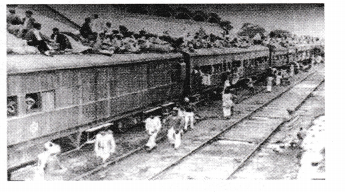
Questions
1. What does this picture represent?
2. Mention some consequences of partition.
3. Which year is being denoted in the picture?
Answer:
1. This picture represents the painful scene of partition of country when people were supposed to leave their homes.
2. (i) Communal Riots (ii) Social Sufferings
(iii) Administrative Concerns and Financial Strains.
3. The year of 1947, most abrupt, unplanned year in the history.
2. Study the picture given below and answer the questions that follow: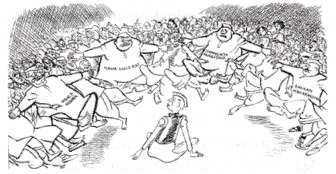
Questions
1. Identify the person in the centre of the cartoon and mention the challenge surrounding him.
2. What does the picture actually refer?
3. How did India avoid all these conflicts?
Answer:
1. The person is the first Prime Minister of India Pt. Jawahar Lai Nehru, who faced the first and foremost challenge of integration of princely states and formation of linguistic states.
2. The picture refers the problem of reorganisation of states on linguistic basis with the fear of disintegration in the country.
3. India identified and respected regional demands of the people and enhanced democracy by providing some autonomy to the states also.
B. On a political outline map of India locate and label the following and symbolise them as indicated: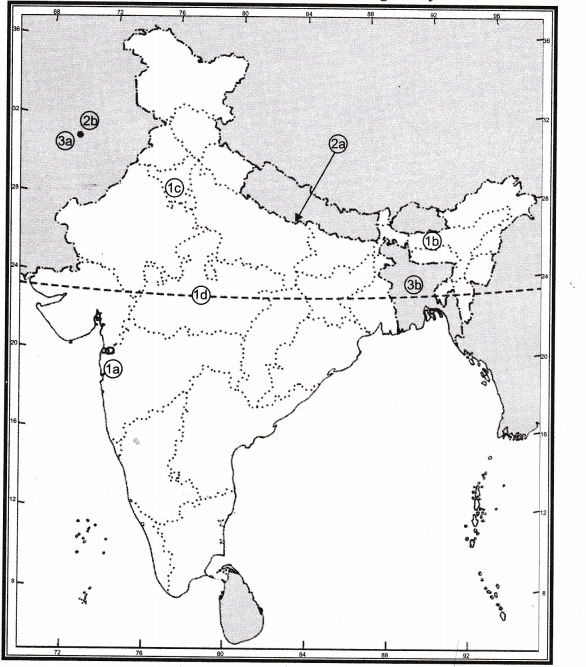
Questions
1. Name and mark the original state from . which the following states were carved out.
(a) Gujarat (b) Meghalaya (c) Haryana (d) Chhattisgarh
2. Name and mark the countries reorganised on religious grounds.
3. Demarcated boundaries of these countries by geographical zones.
Answer:
1. (a) Gujarat (from Bombay)
(b) Meghalaya (from Assam)
(c) Haryana (from Punjab)
(d) Chhattisgarh (from Madhya Pradesh)
2. (a) India (b) Pakistan
3. (a) Pakistan (b) Bangladesh



0 Comments
Please Comment